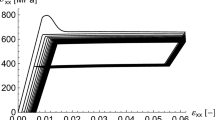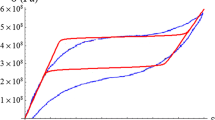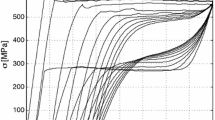Abstract
The phenomenon of functional fatigue occurs during cyclic loading of pseudoelastic shape memory alloys. We model this effect by considering an irreversible martensitic volume fraction in addition to the reversible amounts of austenite and martensite based on variational principles. The inclusion of irreversible martensitic volume fractions coincides with experimental observations and enables the model to be easily calibrated without any fitting functions. In our previous studies, we modeled the polycrystalline material structure by static discretization of a relatively large number of randomly chosen grain orientations, which required much numerical effort. In contrast, we now apply a dynamic representation of the orientation distribution function to the modeling of functional fatigue which has proven to be beneficial regarding the numerical performance. To this end, we take into account an averaged grain orientation parameterized by three Euler angles that serve as additional internal variables. This results in an extremely reduced numerical effort. The model derivation is given along with the numerical implementation and computer experiments on the cyclic behavior of shape memory alloys.

























Similar content being viewed by others
References
Bolotin VV (1999) Mechanics of fatigue, vol 11. CRC Press, Baco Raton
Suresh S (1998) Fatigue of materials. Cambridge university press, Cambridge
Eggeler G, Hornbogen E, Yawny A, Heckmann A, Wagner MF-X (2004) Structural and functional fatigue of NiTi shape memory alloys. Mater Sci Eng A 378(1):24–33
Otsuka K, Wayman CM (1999) Shape memory materials. Cambridge University Press, Cambridge
Otsuka K, Ren X (2005) Physical metallurgy of Ti–Ni-based shape memory alloys. Prog Mate Sci 50(5):511–678
Wagner MF-X (2005) Ein Beitrag zur strukturellen und funktionalen Ermüdung von Drähten und Federn aus NiTi-Formgedächtnislegierungen. Univ.-Verlag, Europe
Burow J (2010) Herstellung, Eigenschaften und Mikrostruktur von ultrafeinkörnigen NiTi-Formgedächtnislegierungen. urn:nbn:de:hbz:294-29048
Delville R, Malard B, Pilch J, Sittner P, Schryvers D (2011) Transmission electron microscopy investigation of dislocation slip during superelastic cycling of Ni-Ti wires. Int J Plast 27(2):282–297
Miyazaki S, Imai T, Igo Y, Otsuka K (1986) Effect of cyclic deformation on the pseudoelasticity characteristics of Ti–Ni alloys. Metall Trans A 17(1):115–120
Ibarra A, San Juan J, Bocanegra EH, Nó ML (2007) Evolution of microstructure and thermomechanical properties during superelastic compression cycling in Cu–Al–Ni single crystals. Acta Mater 55(14):4789–4798
Morgan NB, Friend CM (2001) A review of shape memory stability in NiTi alloys. J Phys 11(Pr8):325
Wagner MF-X, Nayan N, Ramamurty U (2008) Healing of fatigue damage in NiTi shape memory alloys. J Phys D 41(18):185408
Brinson C (1993) One-dimensional constitutive behavior of shape memory alloys: thermomechanical derivation with non-constant material functions and redefined martensite internal variable. J Intell Mater Syst Struct 4(2):229–242
Lexcellent C, Vivet A, Bouvet C, Calloch S, Blanc P (2002) Experimental and numerical determinations of the initial surface of phase transformation under biaxial loading in some polycrystalline shape-memory alloys. J Mech Phys Solids 50(12):2717–2735
Bouvet C, Calloch S, Lexcellent C (2004) A phenomenological model for pseudoelasticity of shape memory alloys under multiaxial proportional and nonproportional loadings. Eur J Mech A 23(1):37–61
Govindjee S, Miehe C (2001) A multi-variant martensitic phase transformation model: formulation and numerical implementation. Comput Methods Appl Mech Eng 191(3):215–238
Stupkiewicz S, Petryk H (2013) A robust model of pseudoelasticity in shape memory alloys. Int J Numer Methods Eng 93(7):747–769
Stupkiewicz S, Petryk H (2002) Modelling of laminated microstructures in stress-induced martensitic transformations. J Mech Phys Solids 50(11):2303–2331
Stein E, Sagar G (2008) Theory and finite element computation of cyclic martensitic phase transformation at finite strain. Int J Numer Methods Eng 74(1):1–31
Mielke A, Theil F, Levitas VI (2002) A variational formulation of rate-independent phase transformations using an extremum principle. Arch Ration Mech Anal 162(2):137–177
Govindjee S, Hall GJ (2000) A computational model for shape memory alloys. Int J Solids Struct 37(5):735–760
Govindjee S, Kasper EP (1999) Computational aspects of one-dimensional shape memory alloy modeling with phase diagrams. Comput Methods Appl Mech Eng 171(3):309–326
Saint-Sulpice L, Chirani SA, Calloch S (2009) A 3D super-elastic model for shape memory alloys taking into account progressive strain under cyclic loadings. Mech Mater 41(1):12–26
Abeyaratne R, Kim S-J (1997) Cyclic effects in shape-memory alloys: a one-dimensional continuum model. Int J Solids Struct 34(25):3273–3289
Abeyaratne R, Kim S-J, Knowles JK (1994) A one-dimensional continuum model for shape-memory alloys. Int J Solids Struct 31(16):2229–2249
Auricchio F, Reali A, Stefanelli U (2007) A three-dimensional model describing stress-induced solid phase transformation with permanent inelasticity. Int J Plast 23(2):207–226
Auricchio F, Petrini L (2004) A three-dimensional model describing stress-temperature induced solid phase transformations: solution algorithm and boundary value problems. Int J Numer Methods Eng 61(6):807–836
Hartl DJ, Chatzigeorgiou G, Lagoudas DC (2010) Three-dimensional modeling and numerical analysis of rate-dependent irrecoverable deformation in shape memory alloys. Int J Plast 26(10):1485–1507
Lagoudas DC, Hartl D, Chemisky Y, Machado L, Popov P (2012) Constitutive model for the numerical analysis of phase transformation in polycrystalline shape memory alloys. Int J Plast 32:155–183
Bo Z, Lagoudas DC (1999) Thermomechanical modeling of polycrystalline SMAs under cyclic loading, part III: evolution of plastic strains and two-way shape memory effect. Int J Eng Sci 37(9):1175–1203
Lagoudas DC, Entchev PB (2004) Modeling of transformation-induced plasticity and its effect on the behavior of porous shape memory alloys. part I: constitutive model for fully dense SMAs. Mech Mater 36(9):865–892
Lagoudas DC (2008) Shape memory alloys: modeling and engineering applications. Springer, New York
Tanaka K, Nishimura F, Hayashi T, Tobushi H, Lexcellent C (1995) Phenomenological analysis on subloops and cyclic behavior in shape memory alloys under mechanical and/or thermal loads. Mech Mater 19(4):281–292
Lexcellent C, Bourbon G (1996) Thermodynamical model of cyclic behaviour of Ti–Ni and Cu–Zn–Al shape memory alloys under isothermal undulated tensile tests. Mech Mater 24(1):59–73
Bartel T, Osman M, Menzel A (2016) A phenomenological model for the simulation of functional fatigue in shape memory alloy wires. Meccanica 52:973
Waimann J, Junker P, Hackl K (2016) A coupled dissipation functional for modeling the functional fatigue in polycrystalline shape memory alloys. Eur J Mech A 55:110–121
Junker P (2014) A novel approach to representative orientation distribution functions for modeling and simulation of polycrystalline shape memory alloys. Int J Numer Methods Eng 98(11):799–818
Simon T, Kröger A, Somsen C, Dlouhy A, Eggeler G (2010) On the multiplication of dislocations during martensitic transformations in NiTi shape memory alloys. Acta Mater 58(5):1850–1860
Krooß P, Niendorf T, Kadletz PM, Somsen C, Gutmann MJ, Chumlyakov YI, Schmahl WW, Eggeler G, Maier HJ (2015) Functional fatigue and tension-compression asymmetry in [001]-oriented Co49Ni21Ga30 high-temperature shape memory alloy single crystals. Shape Memory Superelast 1(1):6–17
Carstensen C, Hackl K, Mielke A (2002) Non-convex potentials and microstructures in finite–strain plasticity. Proc R Soc Lond A 458(2018):299–317
Hackl K, Fischer FD (2008) On the relation between the principle of maximum dissipation and inelastic evolution given by dissipation potentials. Proc R Soc A 464(2089):117–132
Junker P, Makowski J, Hackl K (2014) The principle of the minimum of the dissipation potential for non-isothermal processes. Contin Mech Thermodyn 26(3):259–268
Junker P, Hackl K (2015) A variational growth approach to topology optimization. Struct Multidiscip Optim 52(2):293–304
Günther C, Junker P, Hackl K (2015) A variational viscosity-limit approach to the evolution of microstructures in finite crystal plasticity. Proc R Soc A 471:20150110
Huo Y, Müller I (1993) Nonequilibrium thermodynamics of pseudoelasticity. Contin Mech Thermodyn 5(3):163–204
Junker P, Jaeger S, Kastner O, Eggeler G, Hackl K (2015) Variational prediction of the mechanical behavior of shape memory alloys based on thermal experiments. J Mech Phys Solids 80:86–102
Junker P (2014) An accurate, fast and stable material model for shape memory alloys. Smart Mater Struct 23(11):115010
Hackl K (1999) On the representation of anisotropic elastic materials by symmetric irreducible tensors. Contin Mech Thermodyn 11(6):353–369
Mehrabadi MM, Cowin SC (1990) Eigentensors of linear anisotropic elastic materials. Q J Mech Appl Math 43(1):15–41
Author information
Authors and Affiliations
Corresponding author
Additional information
Submitted to Shape Memory and Superelasticity— Invited Special Issue Contribution [2016].
Rights and permissions
About this article
Cite this article
Waimann, J., Junker, P. & Hackl, K. Modeling the Cyclic Behavior of Shape Memory Alloys. Shap. Mem. Superelasticity 3, 124–138 (2017). https://doi.org/10.1007/s40830-017-0105-4
Published:
Issue Date:
DOI: https://doi.org/10.1007/s40830-017-0105-4




